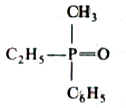Which of the following is not chiral?
2-Butanol
2,3-Dibromopentane
3-Bromopentane
2-Hydroxypropanoic acid
The correct Answer is:C
To determine which of the given molecules is not chiral, we need to analyze each molecule based on the definition of chirality. A molecule is considered chiral if it has a carbon atom bonded to four different substituents. Let's evaluate each of the four molecules step by step.
Step 1: Analyze 2-butanol
- Structure: 2-butanol has the following structure:
- CH3-CH(OH)-CH2-CH3
- Chirality Check: The second carbon (C2) has:
- CH3 (methyl group)
- OH (hydroxyl group)
- CH2CH3 (ethyl group)
- H (hydrogen)
- Since all four substituents are different, 2-butanol is chiral.
Step 2: Analyze 2,3-dibromopentane
- Structure: 2,3-dibromopentane has the following structure:
- CH3-CH(Br)-CH(Br)-CH2-CH3
- Chirality Check: The second carbon (C2) has:
- CH3 (methyl group)
- Br (bromine)
- CH (attached to Br)
- H (hydrogen)
- The third carbon (C3) has:
- Br (bromine)
- CH2 (attached to CH3)
- CH (attached to Br)
- H (hydrogen)
- Both C2 and C3 have four different substituents, so 2,3-dibromopentane is chiral.
Step 3: Analyze 3-bromopentane
- Structure: 3-bromopentane has the following structure:
- CH3-CH2-CH(Br)-CH2-CH3
- Chirality Check: The third carbon (C3) has:
- Br (bromine)
- CH2 (attached to CH2)
- CH2 (attached to CH3)
- H (hydrogen)
- Here, C3 has two identical CH2 groups, meaning it does not have four different substituents. Therefore, 3-bromopentane is not chiral.
Step 4: Analyze 2-hydroxypropanoic acid
- Structure: 2-hydroxypropanoic acid has the following structure:
- CH3-CH(OH)-C(=O)OH
- Chirality Check: The second carbon (C2) has:
- CH3 (methyl group)
- OH (hydroxyl group)
- C(=O)OH (carboxylic acid)
- H (hydrogen)
- Since all four substituents are different, 2-hydroxypropanoic acid is chiral.
Conclusion
From the analysis, we find that:
- 2-butanol: Chiral
- 2,3-dibromopentane: Chiral
- 3-bromopentane: Not chiral
- 2-hydroxypropanoic acid: Chiral
Thus, the molecule that is not chiral is 3-bromopentane.
- Structure: 2-butanol has the following structure:
- CH3-CH(OH)-CH2-CH3
- Chirality Check: The second carbon (C2) has:
- CH3 (methyl group)
- OH (hydroxyl group)
- CH2CH3 (ethyl group)
- H (hydrogen)
- Since all four substituents are different, 2-butanol is chiral.
- Structure: 2,3-dibromopentane has the following structure:
- CH3-CH(Br)-CH(Br)-CH2-CH3
- Chirality Check: The second carbon (C2) has:
- CH3 (methyl group)
- Br (bromine)
- CH (attached to Br)
- H (hydrogen)
- The third carbon (C3) has:
- Br (bromine)
- CH2 (attached to CH3)
- CH (attached to Br)
- H (hydrogen)
- Both C2 and C3 have four different substituents, so 2,3-dibromopentane is chiral.
- Structure: 3-bromopentane has the following structure:
- CH3-CH2-CH(Br)-CH2-CH3
- Chirality Check: The third carbon (C3) has:
- Br (bromine)
- CH2 (attached to CH2)
- CH2 (attached to CH3)
- H (hydrogen)
- Here, C3 has two identical CH2 groups, meaning it does not have four different substituents. Therefore, 3-bromopentane is not chiral.
- Structure: 2-hydroxypropanoic acid has the following structure:
- CH3-CH(OH)-C(=O)OH
- Chirality Check: The second carbon (C2) has:
- CH3 (methyl group)
- OH (hydroxyl group)
- C(=O)OH (carboxylic acid)
- H (hydrogen)
- Since all four substituents are different, 2-hydroxypropanoic acid is chiral.
From the analysis, we find that:
- 2-butanol: Chiral
- 2,3-dibromopentane: Chiral
- 3-bromopentane: Not chiral
- 2-hydroxypropanoic acid: Chiral
Similar Questions
Knowledge Check
- Question 1 - Select One
Which of the following is a chiral molecule?
A1-chloro propaneB2-chloro propaneC1-chloro butaneD2-chloro butane - Question 2 - Select One
Which of the following is chiral?
ACell phoneBSpiral staircaseCScissorDAll of these - Question 3 - Select One or More
Which of the following is chiral?
A B
B C
C D
D


